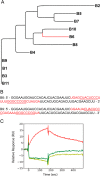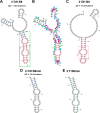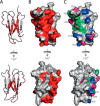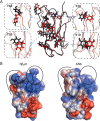Distinguishing closely related amyloid precursors using an RNA aptamer
- PMID: 25100729
- PMCID: PMC4175327
- DOI: 10.1074/jbc.M114.595066
Distinguishing closely related amyloid precursors using an RNA aptamer
Abstract
Although amyloid fibrils assembled in vitro commonly involve a single protein, fibrils formed in vivo can contain multiple protein sequences. The amyloidogenic protein human β2-microglobulin (hβ2m) can co-polymerize with its N-terminally truncated variant (ΔN6) in vitro to form hetero-polymeric fibrils that differ from their homo-polymeric counterparts. Discrimination between the different assembly precursors, for example by binding of a biomolecule to one species in a mixture of conformers, offers an opportunity to alter the course of co-assembly and the properties of the fibrils formed. Here, using hβ2m and its amyloidogenic counterpart, ΔΝ6, we describe selection of a 2'F-modified RNA aptamer able to distinguish between these very similar proteins. SELEX with a N30 RNA pool yielded an aptamer (B6) that binds hβ2m with an EC50 of ∼200 nM. NMR spectroscopy was used to assign the (1)H-(15)N HSQC spectrum of the B6-hβ2m complex, revealing that the aptamer binds to the face of hβ2m containing the A, B, E, and D β-strands. In contrast, binding of B6 to ΔN6 is weak and less specific. Kinetic analysis of the effect of B6 on co-polymerization of hβ2m and ΔN6 revealed that the aptamer alters the kinetics of co-polymerization of the two proteins. The results reveal the potential of RNA aptamers as tools for elucidating the mechanisms of co-assembly in amyloid formation and as reagents able to discriminate between very similar protein conformers with different amyloid propensity.
Keywords: Amyloid; Amyloid Fibril; Amyloid Precursor; Aptamer; Co-polymerization; Protein Aggregation; Protein Folding; RNA Aptamer; Structural Biology; β2-Microglobulin.
© 2014 by The American Society for Biochemistry and Molecular Biology, Inc.
Figures










Similar articles
-
Secondary structure in the core of amyloid fibrils formed from human β₂m and its truncated variant ΔN6.J Am Chem Soc. 2014 Apr 30;136(17):6313-25. doi: 10.1021/ja4126092. Epub 2014 Apr 16. J Am Chem Soc. 2014. PMID: 24679070 Free PMC article.
-
Extracellular matrix components modulate different stages in β2-microglobulin amyloid formation.J Biol Chem. 2019 Jun 14;294(24):9392-9401. doi: 10.1074/jbc.RA119.008300. Epub 2019 Apr 17. J Biol Chem. 2019. PMID: 30996004 Free PMC article.
-
Expanding the repertoire of amyloid polymorphs by co-polymerization of related protein precursors.J Biol Chem. 2013 Mar 8;288(10):7327-37. doi: 10.1074/jbc.M112.447524. Epub 2013 Jan 17. J Biol Chem. 2013. PMID: 23329840 Free PMC article.
-
Assessing the causes and consequences of co-polymerization in amyloid formation.Prion. 2013 Sep-Oct;7(5):359-68. doi: 10.4161/pri.26415. Epub 2013 Sep 11. Prion. 2013. PMID: 24025483 Free PMC article. Review.
-
Glimpses of the molecular mechanisms of beta2-microglobulin fibril formation in vitro: aggregation on a complex energy landscape.FEBS Lett. 2009 Aug 20;583(16):2623-9. doi: 10.1016/j.febslet.2009.05.005. Epub 2009 May 9. FEBS Lett. 2009. PMID: 19433089 Free PMC article. Review.
Cited by
-
A Population Shift between Sparsely Populated Folding Intermediates Determines Amyloidogenicity.J Am Chem Soc. 2016 May 18;138(19):6271-80. doi: 10.1021/jacs.6b02464. Epub 2016 May 6. J Am Chem Soc. 2016. PMID: 27117876 Free PMC article.
-
G-quadruplex formation in RNA aptamers selected for binding to HIV-1 capsid.Front Chem. 2024 Oct 22;12:1425515. doi: 10.3389/fchem.2024.1425515. eCollection 2024. Front Chem. 2024. PMID: 39502140 Free PMC article.
-
Amyloid plaques beyond Aβ: a survey of the diverse modulators of amyloid aggregation.Biophys Rev. 2017 Aug;9(4):405-419. doi: 10.1007/s12551-017-0271-9. Epub 2017 Jun 19. Biophys Rev. 2017. PMID: 28631243 Free PMC article. Review.
-
FaptaSyme: A Strategy for Converting a Monomer/Oligomer-Nonselective Aptameric Sensor into an Oligomer-Selective One.Chembiochem. 2018 Apr 26:10.1002/cbic.201800017. doi: 10.1002/cbic.201800017. Online ahead of print. Chembiochem. 2018. PMID: 29700982 Free PMC article.
References
Publication types
MeSH terms
Substances
Grants and funding
LinkOut - more resources
Full Text Sources
Other Literature Sources

